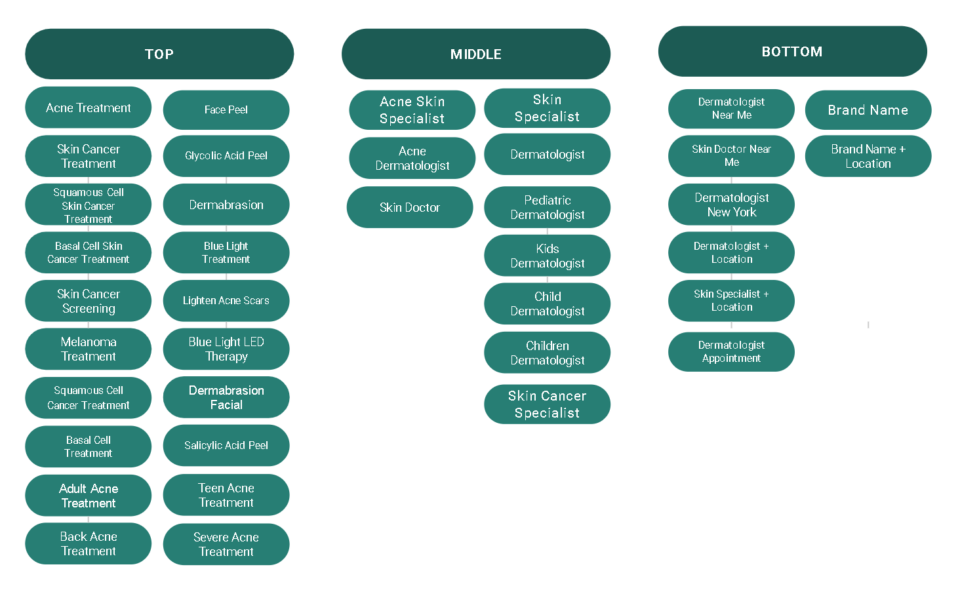There are levels to the Google Ads game. Typically, we start healthcare organizations out at the first level: using Google Ads to capture existing bottom-of-funnel (BOF) demand. At this stage, prospects are most aware: they know the solution they need and know that you offer it. Targeting this group is the fastest (and most practical) way to quickly increase patient volume.
In other words, it’s the low-hanging fruit.
However, as healthcare organizations level up and mature, they need new Google Ads strategies to compete. At some point, you’ll capture 100% of existing BOF demand. To win, you’ll need to generate demand and influence healthcare decisions earlier in the funnel.
This is where performance branding comes in.
A Powerful Way to Breakthrough the Growth Plateau
They say that the hardest part of a weight loss program is losing those last ten pounds. Why? Because to get to that point, you’ve already taken care of the low-hanging fruit—the fundamental diet and lifestyle changes. To shed that remaining weight, you have to do the difficult thing—you have to get very precise, efficient, and consistent.
This is where most people plateau.
The same goes for the marketing funnel. Let’s say your BOF campaigns are capturing existing demand and driving traffic from searches like “dentist near me” and “best dentist atlanta.” You’ve implemented all of the optimizations you can, leading to great conversion rates (CVR) and low cost per acquisition (CPA). However, you’re only gaining marginal increases in patient volume.
To “shed the last ten pounds” and break through the plateau, you need to find a new edge in a fiercely competitive market. Amidst such a saturated field, there’s no real standout selling proposition—to healthcare consumers, it often looks like a big, homogenized amalgam of providers. In the end, whoever appears first on the search engine results page tends to win a patient’s business.
No wonder you’re seeing a slow-down in patient volume. At this level of marketing maturity—and under these circumstances—traditional brand marketing just won’t cut it. You need to start building demand earlier so that consumers are looking for your brand.
Brand Marketing vs. Performance Marketing
With brand marketing, the goal is to build a name that people trust, connect with, and believe in. This strategy isn’t new to most hospital marketers but isn’t used as often by low-acuity healthcare groups.
According to Amazon Ads, brand marketing “promotes the entirety of the brand, using the products and services as proof points that support the brand’s promise. The goal of brand marketing is to build a brand’s value – and the company’s value, as a result, defines brand marketing.”
Brand marketing encompasses many things, including brand guidelines, audience research, and company values. Practical applications of brand marketing vary widely, too. Have you ever reached the end of a commercial and said to yourself, “Wait, this is an ad for a car?” That’s brand marketing: it’s less about the product or service, more about the spirit that the brand embodies.
Examples of Healthcare Brand Marketing
- UnitedHealthcare’s “We Dare You To…” interactive campaign
- Video storytelling like New York-Presbyterian Patient Stories
- Dana-Farber Brigham & Women’s Cancer Center’s You Have Us campaign
On the other hand, performance marketing is more rooted in data. We know that data-driven personalization can significantly improve campaign ROI. According to research from McKinsey, “with a clearer understanding of consumer preferences and behavior at the early stages of their buying journey, companies report marketing efficiency gains of up to 30 percent and incremental top-line growth of up to 10 percent.”
So what does this look like in healthcare marketing?
If the top-of-funnel (TOF) data tells us that our target demographic starts their search worried about symptoms, we can develop ads that promote educational content that addresses their fears and helps them understand their medical condition.
Examples of Performance Marketing
- Search engine optimization (SEO)
- Google and Bing Ads
- Conversion rate optimization for ad landing pages
What Performance Marketing Looks Like in Practice
The McKinsey data is mouth-watering. Thirty percent efficiency gains for marketing activities? A 10 percent increase in incremental top-line growth? To achieve this kind of increase in market share, patient volume, and so on, you need to closely align branding activities with business goals.
Here’s what we recommend:
An Intent-Based Keyword Strategy
Savvy marketers have realized something about keyword strategies: just because a keyword is high-volume doesn’t necessarily mean it will win you quality conversions. Instead, those marketers organize their advertising strategy around the keywords living in the top, middle, and bottom of their funnels.

Take an acne treatment specialist, for example. Here’s a sampling of keywords from each part of their funnel:
TOF Keywords (Problem Aware)
- Acne treatment
- Face peel
- Skin cancer treatment
MOF Keywords (Solution Aware)
- Acne skin specialist
- Skin doctor
- Dermatologists
BOF Keywords (Product/Most Aware)
- Dermatologist near me
- Skin doctor + [location]
- Dermatologist appointment
An intent-based keyword strategy tends to perform better by optimizing keywords, campaigns, and ad creative around what people in each stage actually intend to do.
Social Media Prospecting
Social media can be used to increase awareness and reach a new audience, too—all in line with the core tenets of performance branding. Here’s an example formula for social media prospecting that we recommend for our own clients:
- Publish video content to reach new audiences and make them aware of your brand and services (move them from problem to solution aware).
- Re-engage the more qualified audience (per your engagement metrics) with video, carousel, and slideshow content. Make this more receptive audience aware of why they should choose your brand.
- Target the most qualified (first-party) audiences created by the upper funnel campaigns to generate actual leads.
You do more with this formula than publish branded TOF video content to social media; you refine, target, and convert audiences based on the data.
Full-Funnel Paid Social
Similar to prospecting, the idea here is to run social media ads in a way that reduces the overall cost of generating a BOF lead. Failing to do so can be costly. We see many healthcare organizations serving direct response ads to prospects who’ve never interacted with their brand before. And we’ve seen this disconnect drive up the cost per acquisition (CPA) well over 400%.
That’s not performance-driven at all.
Instead, we recommend a full-funnel approach to keep reach wide where the cost to serve the ads is low. We only push qualified audiences down the funnel to the ads containing CTAs. It’s what we and others in the industry call a full-funnel paid social strategy.
With Marketing Success Comes New Innovation
Healthcare marketing is all about levels. We’ve seen it a million times: marketing teams get really good at snatching up BOF demand with Google Ads and then hit a wall. Patient acquisition plateaus (if it doesn’t fall off the cliff entirely). All of a sudden, what used to work can’t, and won’t, work anymore.
The good news is that in the lead up to this plateau, you’ve likely amassed a fair amount of data. Even if your campaigns are disorganized and your data a mess, you’re still in a position to take full advantage of performance branding. It just might take some time and maybe, just maybe, the right healthcare marketing agency.

